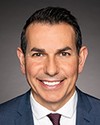Welcome, members. I call this meeting to order.
Welcome to meeting number 24 of the House of Commons Standing Committee on Finance. Pursuant to the motion adopted in committee on January 12, 2022, the committee is meeting on inflation in the current Canadian economy.
Today's meeting is taking place in a hybrid format pursuant to the House order of November 25, 2021. Members are attending in person in the room and remotely using the Zoom application. The proceedings will be made available via the House of Commons website. The webcast will always show the person speaking, rather than the entirety of the committee.
Today's meeting is also taking place in the webinar format. Webinars are for public committee meetings and are available only to members, their staff and witnesses. Members enter immediately as active participants. All functionalities for active participants remain the same. Staff will be non-active participants and can, therefore, view the meeting only in gallery view.
I would like to take this opportunity to remind all participants to this meeting that screenshots or taking photos of your screen are not permitted.
Given the ongoing pandemic situation and in light of the recommendations from the health authorities, as well as the directive of the Board of Internal Economy on October 19, 2021, to remain healthy and safe, all those attending the meeting in person are to maintain two-metre physical distancing and must wear a non-medical mask when circulating in the room. It is highly recommended that the mask be worn at all times, including when seated. We must also maintain proper hand hygiene by using the provided hand sanitizer at the room entrance. As the chair, I will be enforcing these measures for the duration of the meeting, and I thank members in advance for their co-operation.
To ensure an orderly meeting, I would like to outline a few rules to follow.
Members and witnesses may speak in the official language of their choice. Interpretation services are available for this meeting. You have the choice at the bottom of your screen of floor, English or French audio. If interpretation is lost, please inform me immediately and we will ensure that interpretation is properly restored before resuming the proceedings. The “raise hand” feature at the bottom of the screen can be used at any time if you wish to speak or alert the Chair.
For members participating in person, proceed as you usually would when the whole committee is meeting in person in a committee room. Keep in mind the Board of Internal Economy's guidelines for mask use and health protocols.
Before speaking, please wait until I recognize you by name. If you are on the video conference, please click on the microphone icon to unmute yourself. For those in the room, your microphone will be controlled as normal by the proceedings and verification officer. When speaking, please speak slowly and clearly. When you're not speaking, your mike should be on mute. I would remind you that all comments by members and witnesses should be addressed through the Chair.
With regard to a speaking list, the committee clerk and I will do our best to maintain a consolidated order of speaking for all members, whether they are participating virtually or in person.
The committee agreed that during these hearings, the chair will enforce the rule that the response by a witness to a question take no longer than the time taken to ask the question. That being said, I request that members and witnesses mutually treat each other with respect and decorum. If you think the witness has gone beyond the time, it is the member's prerogative to interrupt or ask the next question, and to be mindful of other members' time allocation during the meeting.
I also request that members not go much over their allotted question time. Though we will not interrupt during a member's allotted time, I would like to keep you informed that our clerk has two clocks to time our members and witnesses.
I would now like to welcome today's witnesses. From the Bank of Canada, we have with us Governor Tiff Macklem. Welcome. We also have Senior Deputy Governor Carolyn Rogers. I would like to convey my sincere thanks to the governor and senior deputy governor. We understand this has been an extremely busy time for you. On behalf of the Standing Committee on Finance and its members, we want to thank you for honouring our request to come before our committee.
Governor, the floor is yours for opening remarks.




